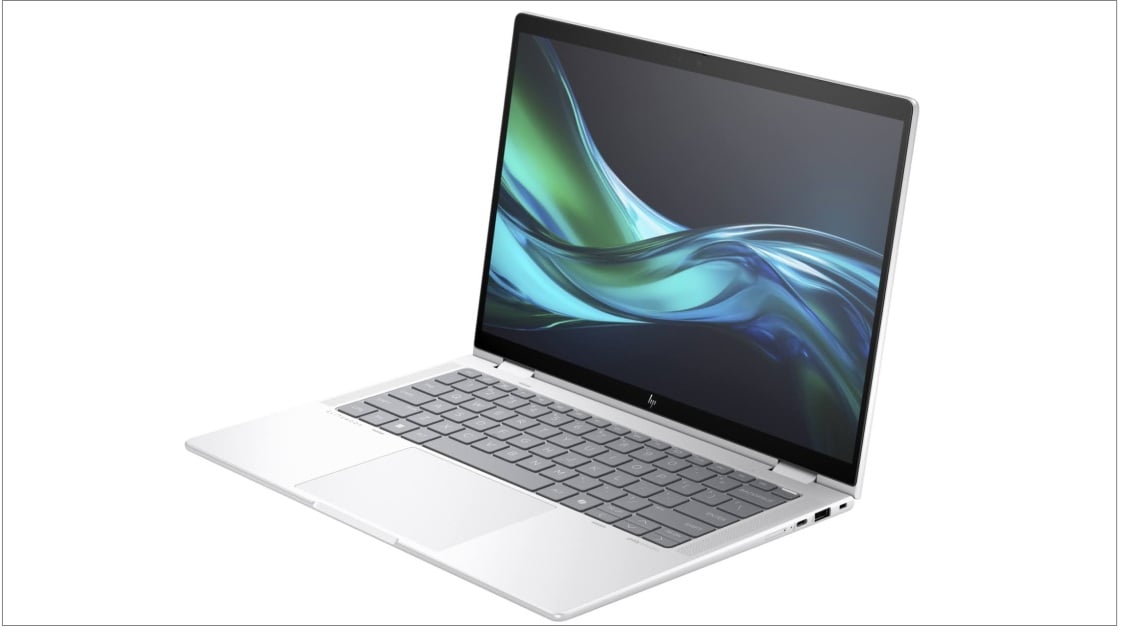
For the past few weeks, I’ve been using an HP Elite X360 1040G11 as my primary laptop, and I’ve been impressed. It offers strong performance and battery life, as well as a premium design with a number of additional features.As the name implies, this is the 11th generation of HP’s premium enterprise 2-in-1 convertible. You can use it as a traditional laptop, but it features a hinge that lets you rotate the screen completely flat on the back of the unit, so you can also use it as a tablet. It also comes with a pen for drawing or notetaking.
(Credit: HP)
While I typically find 2-in-1s to be too big as tablets, I do appreciate the flexibility such machines offer when it comes to giving presentations or watching media. And the pen worked very well. For folks who prefer a traditional “clamshell” laptop, HP makes the EliteBook 1040, which is essentially the same machine minus the hinge and the pen. I note that although the official name of the machine I tested is the Elite X360, the machine itself says EliteBook just below the keyboard.Measuring 12.36 by 8.6 by 0.41 to 0.58 inches (front to rear), with the version I tested weighing 3.28 pounds (3.91 pounds with the included 65-watt charger and 3.95 pounds if you include the HP Pen), the Elite 1040 is a bit thinner and heavier than the Lenovo ThinkPad X1 2-in-1 I tested earlier. It has an aluminum frame and cover, this year with a new “Glacier Silver” color that is a few shades lighter than the silver or gray colors I’ve seen on many machines. Compared with previous machines in the model, it has a slightly larger touchpad and larger keycaps, and it felt very solid.
(Credit: HP)
Other new features include an integrated power button and fingerprint sensor on the upper right-hand corner of the keyboard, and the now-standard Windows Copilot key.The model I used had a 14-inch IPS touch screen with 1,920-by-1,200 resolution and 400 nits of brightness, which is pretty standard for this class of machine; a 2,880-by-1,800 OLED display is also available, as are two options for privacy screens. I didn’t test these, though in the past I’ve been impressed by HP’s privacy screens. The included display looked good, though I’m sure the OLED would have been better.
(Credit: HP)
I was particularly impressed by the number and layout of the ports. The left side of the machine has an HDMI 2.1 port, two USB-C/Thunderbolt, and a 3.5mm audio jack, while the right side has a locking slot, 5Gbps USB-A, a 10Gbps USB-C, and an optional SIM card reader. (My model included the optional WWAN 5G modem.) I like having both USB-A and HDMI, which some enterprise laptops leave out, while still having USB-C on both sides, which makes for easier charging.For video conferencing, the Elite X360 comes with a 5MP IR camera that seemed okay—far from the best I’ve seen, but also far from the worst—and had a very large field of view. It supposedly had dynamic color tuning to correct your image, but I still didn’t think it was nearly as good as the camera on HP’s EliteBook Ultra G1q.
(Credit: HP)
As with most of the current Windows systems, it supports Studio Effects for things like background blur. There’s also a separate Poly Camera Pro app (that you need to download from the Microsoft Store via the myHP app) that offers many more options for framing and zooming, as well as more scenes and watermarks—if you want to always display your name, for example. The camera itself worked fine with features such as turning off the display when you leave and waking when you approach; and worked well with Windows Hello. As I prefer, the Elite 1040 includes a physical webcam shutter. For audio, it has two top and two bottom-firing speakers with discrete amplifiers and dual-array microphones. It had very good sound for a business laptop.The myHP application also includes ways to manage the programmable key, get to support, and a Smart Sense application that balances performance, fan noise, and cooling. This seemed to work pretty well. Other applications include a separate HP Audio Controls app, which worked fine, although I’m still not sure why this couldn’t be combined into the main myHP app.It also comes with three years of HP’s Wolf Pro Security, which includes malware prevention, threat containment, and HP’s Sure Run technology to isolate specific applications.The model I had included an Intel Core Ultra 7 165H processor, a slightly higher-end version of the “Meteor Lake” processors I’ve seen on other similar laptops, along with 16GB of RAM and a 512GB SSD. This is a 28-watt processor with six performance cores (each of which can do multithreading), eight efficient cores, and two low-power efficient cores, for a total of 16 cores and 22 threads. The performance cores have a base frequency of 1.4GHz, with a maximum turbo speed of 5.0GHz. It has Intel Graphics with 8 Xe cores at a maximum of 2.3GHz. The processor is vPro capable.Probably as a result, I got higher scores on most of my benchmark tests than I saw with the X1 2-in-1 (which ran a 15-watt Core Ultra 7 155U) or the X1 Carbon Gen 12 (which ran a 28-watt Core Ultra 7 155H) but somewhat lower than I saw with the Lenovo Yoga Pro 9i 16 (a larger machine that ran a 45-watt Core Ultra 7 185H). And, of course, the latter machine with its discrete graphics was significantly better at graphics.
Recommended by Our Editors
On my toughest tests, it transcoded a large video in Handbrake in 1 hour and 19 minutes, compared with 1 hour and 36 minutes on the X1 2-in-1 and 1:16 on the X1 Carbon Gen 12. Similarly, it ran a portfolio simulation in MATLAB in just under 32 minutes compared with a little over 34 minutes on the X1 2-in-1, but not as good as the 30 minutes on the X1 Carbon Gen 12. Running a large Excel data table model took 45 minutes compared with 47 for the X1 2-in-1 and 46 for the X1 Carbon Gen 12. But note that none of these numbers are anywhere as good as what I saw on last year’s Core i7 (Raptor Lake)-based system, which could finish in as little as 35 minutes.On AI tests, scores were similar to the other Meteor Lake systems with integrated graphics I’ve tested. Machines with discrete graphics still seem to do much better, and while Meteor Lake has an NPU it doesn’t seem strong enough to run most AI models well.Battery life was very strong. On PCMark 10’s Modern Office battery test, I got 17 hours and 38 minutes at 100 nits, and 19 hours and 46 minutes at 40 nits, the best I’ve seen on an Intel-based laptop. It has a 68-watt-hour battery.Currently, on HP’s site, a system similar to the one I tested sells for $2,299 including the Core Ultra 7 165H, 16GB of RAM, 512GB SSD, standard display, and a 5G modem. A system with a Core Ultra 5 125 H processor and without the WWAN modem starts at $1,499. Such systems aren’t cheap, but they do seem competitive. Overall, the Elite x360 1040 G11 is a solid 2-in-1 with great performance and a few extras.
Get Our Best Stories!
Sign up for What’s New Now to get our top stories delivered to your inbox every morning.
This newsletter may contain advertising, deals, or affiliate links. Subscribing to a newsletter indicates your consent to our Terms of Use and Privacy Policy. You may unsubscribe from the newsletters at any time.
About Michael J. Miller
Former Editor in Chief
Michael J. Miller is chief information officer at Ziff Brothers Investments, a private investment firm. From 1991 to 2005, Miller was editor-in-chief of PC Magazine,responsible for the editorial direction, quality, and presentation of the world’s largest computer publication. No investment advice is offered in this column. All duties are disclaimed. Miller works separately for a private investment firm which may at any time invest in companies whose products are discussed, and no disclosure of securities transactions will be made.
Read Michael J.’s full bio
Read the latest from Michael J. Miller






